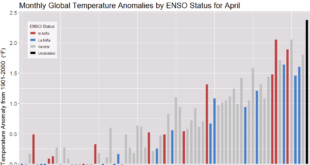 From the climate.gov article Brief periods of dangerous humid heat arrive decades early by Alison Stevens (5/12/2020):
From the climate.gov article Brief periods of dangerous humid heat arrive decades early by Alison Stevens (5/12/2020):
The paper authors used an index called “wet-bulb temperature” based on weather station temperature and humidity data. The reading, from a thermometer when covered in a wet cloth, is related to how muggy conditions feel. This map shows locations that experienced extreme heat and humidity levels briefly (hottest 0.1 percent of daily maximum wet-bulb temperatures) from 1979–2017. Darker colors show more severe combinations of heat and humidity. Some areas have already experienced conditions at or near humans’ survivability limit of 35°C (95°F).
Who’s close to the 95°F?
The authors identified over 7,000 past occurrences of wet-bulb temperatures above 88°F (31°C), over 250 above 91°F (33°C) around the world, and two stations that reported multiple daily-maximum wet-bulb temperatures above 95°F. These extremes occurred for 1–2 hours in parts of coastal southwest North America, South Asia, and the coastal Middle East.
The southeastern United States, especially along the Gulf of Mexico, had multiple incidences of wet-bulb temperatures at or above 88°F; specifically, in east Texas, Louisiana, Mississippi, Alabama, the Florida Panhandle, Arkansas, and North Carolina. Parts of India, Pakistan, northwestern Australia, the coast of the Red Sea, and areas along the Gulf of California in Mexico saw even higher extremes.
The article links to the original paper.
